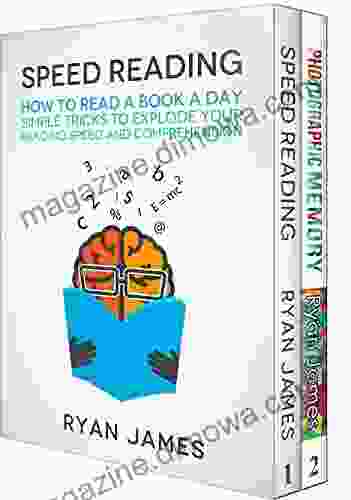How to Read Day Photographic Memory: Unlock the Secrets of Photographic Memory

Have you ever wished you could read day photographic memory? Imagine being able to instantly recall any information you've ever read, from the smallest details to the big picture. With a photographic memory, you could ace exams, learn new languages, and become an expert in any subject you choose.
4.3 out of 5
| Language | : | English |
| File size | : | 3165 KB |
| Text-to-Speech | : | Enabled |
| Screen Reader | : | Supported |
| Enhanced typesetting | : | Enabled |
| Print length | : | 131 pages |
| Lending | : | Enabled |
| Paperback | : | 205 pages |
| Item Weight | : | 1.38 pounds |
| Dimensions | : | 8.27 x 0.47 x 11.69 inches |
The good news is that a photographic memory is not just a dream. It's a skill that can be learned by anyone with the right techniques and practice.
In this comprehensive guide, we'll teach you everything you need to know about how to read day photographic memory. We'll cover:
- The science of photographic memory
- The different types of photographic memory
- The best techniques for developing a photographic memory
- How to use a photographic memory to improve your life
The Science of Photographic Memory
Photographic memory, also known as eidetic memory, is the ability to recall images, sounds, and other sensory information in great detail. People with photographic memories can often remember things they've seen or heard only once, even years later.
The science of photographic memory is still not fully understood, but there is some evidence that it may be due to differences in brain structure and function. Studies have shown that people with photographic memories have larger hippocampi, which is the part of the brain responsible for memory formation.
There is also some evidence that photographic memory may be genetic. A study of identical twins found that identical twins were more likely to have photographic memories than fraternal twins.
The Different Types of Photographic Memory
There are two main types of photographic memory:
- Iconic memory is the ability to hold an image in your mind for a short period of time, usually for less than a second.
- Echoic memory is the ability to hold a sound in your mind for a short period of time, usually for less than four seconds.
Most people have some degree of iconic and echoic memory, but only a few people have the ability to hold images or sounds in their minds for longer periods of time.
In addition to iconic and echoic memory, there is also a third type of photographic memory called procedural memory. Procedural memory is the ability to remember how to do things, such as how to ride a bike or play the piano. Procedural memory is not as well-understood as iconic and echoic memory, but it is thought to be stored in a different part of the brain.
The Best Techniques for Developing a Photographic Memory
There are a number of different techniques that can be used to develop a photographic memory. Some of the most effective techniques include:
- Chunking is the process of breaking down information into smaller, more manageable pieces. When you chunk information, you make it easier to remember because your brain can process it more efficiently.
- Spaced repetition is the process of reviewing information at spaced intervals. When you space out your review sessions, you help your brain to consolidate the information and make it more likely that you'll remember it in the long term.
- Active recall is the process of trying to recall information from memory without looking at your notes. Active recall is a more effective way to learn than simply reading and re-reading your notes.
- Visualization is the process of creating mental images of the information you're trying to remember. Visualization can help you to remember information more easily because it creates a stronger connection between the information and your brain.
It's important to note that there is no one-size-fits-all approach to developing a photographic memory. The best techniques for you will depend on your individual learning style and preferences. Experiment with different techniques and find the ones that work best for you.
How to Use a Photographic Memory to Improve Your Life
A photographic memory can be a powerful tool for improving your life. Here are just a few of the ways that you can use a photographic memory to your advantage:
- Ace exams: With a photographic memory, you can easily remember all of the information you need to know for your exams. This means you can spend less time studying and more time enjoying your life.
- Learn new languages: Learning a new language can be difficult, but it's much easier if you have a photographic memory. With a photographic memory, you can quickly memorize new vocabulary and grammar rules.
- Become an expert in any subject: If you have a photographic memory, you can become an expert in any subject you choose. Simply read about the subject and your brain will automatically remember everything you learn.
- Improve your memory: A photographic memory can help you to improve your memory in general. By practicing the techniques that we've discussed in this guide, you can strengthen your memory and make it easier to remember everything you need to know.
A photographic memory is a valuable skill that can help you to improve your life in many ways. If you're willing to put in the time and effort, you can develop a photographic memory and unlock your full potential.
4.3 out of 5
| Language | : | English |
| File size | : | 3165 KB |
| Text-to-Speech | : | Enabled |
| Screen Reader | : | Supported |
| Enhanced typesetting | : | Enabled |
| Print length | : | 131 pages |
| Lending | : | Enabled |
| Paperback | : | 205 pages |
| Item Weight | : | 1.38 pounds |
| Dimensions | : | 8.27 x 0.47 x 11.69 inches |
Do you want to contribute by writing guest posts on this blog?
Please contact us and send us a resume of previous articles that you have written.
 Book
Book Novel
Novel Page
Page Chapter
Chapter Text
Text Story
Story Genre
Genre Reader
Reader Library
Library Paperback
Paperback E-book
E-book Magazine
Magazine Newspaper
Newspaper Paragraph
Paragraph Sentence
Sentence Bookmark
Bookmark Shelf
Shelf Glossary
Glossary Bibliography
Bibliography Foreword
Foreword Preface
Preface Synopsis
Synopsis Annotation
Annotation Footnote
Footnote Manuscript
Manuscript Scroll
Scroll Codex
Codex Tome
Tome Bestseller
Bestseller Classics
Classics Library card
Library card Narrative
Narrative Biography
Biography Autobiography
Autobiography Memoir
Memoir Reference
Reference Encyclopedia
Encyclopedia Brandon Pullan
Brandon Pullan John Fox
John Fox Joe Karam
Joe Karam Oscar Wilde
Oscar Wilde Brie Spangler
Brie Spangler Nancy E Wood
Nancy E Wood Joan Irvine
Joan Irvine Luke Daly Groves
Luke Daly Groves Kathy Petrakis
Kathy Petrakis Sherril Dodds
Sherril Dodds Philipp Schubert
Philipp Schubert John Calipari
John Calipari Sidney Gray
Sidney Gray Mary Da Prato
Mary Da Prato Mike Weinberg
Mike Weinberg Sam Ricks
Sam Ricks Silvana Fiorito
Silvana Fiorito Justin Carrier
Justin Carrier Joan G Robinson
Joan G Robinson John Feinstein
John Feinstein
Light bulbAdvertise smarter! Our strategic ad space ensures maximum exposure. Reserve your spot today!

 Bradley DixonUnveiling the Mathematical Genius of John Littlewood: An Exploration of the...
Bradley DixonUnveiling the Mathematical Genius of John Littlewood: An Exploration of the... Morris CarterFollow ·3.9k
Morris CarterFollow ·3.9k Jeffery BellFollow ·18k
Jeffery BellFollow ·18k Ethan GrayFollow ·9.9k
Ethan GrayFollow ·9.9k Miguel NelsonFollow ·15.3k
Miguel NelsonFollow ·15.3k Elliott CarterFollow ·12.8k
Elliott CarterFollow ·12.8k Seth HayesFollow ·6.5k
Seth HayesFollow ·6.5k W.H. AudenFollow ·16.3k
W.H. AudenFollow ·16.3k Galen PowellFollow ·14.7k
Galen PowellFollow ·14.7k

 Joshua Reed
Joshua ReedTake Your Marketing Business Into The Next Level
Are you ready to...

 Aaron Brooks
Aaron BrooksFrom Fourier to Cauchy-Riemann: Geometry Cornerstones
From Fourier to Cauchy-Riemann: Geometry...

 Orson Scott Card
Orson Scott CardUnveiling the Art of Mitigation Banking: A Comprehensive...
In the intricate dance between...

 Victor Hugo
Victor HugoUnleash Your Creativity: A Journey Through the Enchanting...
Prepare to be captivated as we...

 Duncan Cox
Duncan CoxLoad of Bull: An Englishman's Adventures in Madrid
By Simon Bunce ...
4.3 out of 5
| Language | : | English |
| File size | : | 3165 KB |
| Text-to-Speech | : | Enabled |
| Screen Reader | : | Supported |
| Enhanced typesetting | : | Enabled |
| Print length | : | 131 pages |
| Lending | : | Enabled |
| Paperback | : | 205 pages |
| Item Weight | : | 1.38 pounds |
| Dimensions | : | 8.27 x 0.47 x 11.69 inches |












